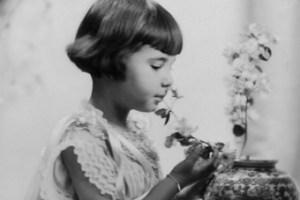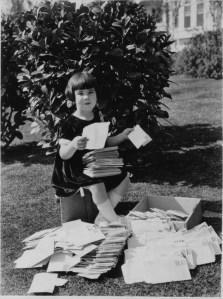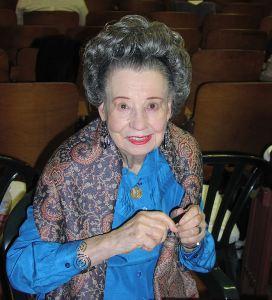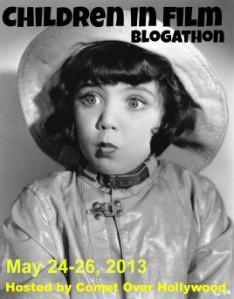 Baby Peggy began her career in film at an age when most of her peers were more concerned with learning their shapes and colors. She was a full-fledged movie star by the age of 5, ranking alongside the likes of Mary Pickford and Rudolph Valentino in terms of box-office appeal. Baby Peggy was making over a million dollars a year, earning her the nickname of the “Million Dollar Baby.” And then her career ended just as suddenly as it started. By the time she was 8 years old, she was already a “has-been” in the movie world and she was left to spend the rest of her life struggling to come to terms with life in the shadow of her Baby Peggy persona.
Baby Peggy began her career in film at an age when most of her peers were more concerned with learning their shapes and colors. She was a full-fledged movie star by the age of 5, ranking alongside the likes of Mary Pickford and Rudolph Valentino in terms of box-office appeal. Baby Peggy was making over a million dollars a year, earning her the nickname of the “Million Dollar Baby.” And then her career ended just as suddenly as it started. By the time she was 8 years old, she was already a “has-been” in the movie world and she was left to spend the rest of her life struggling to come to terms with life in the shadow of her Baby Peggy persona.
Baby Peggy was born Peggy-Jean Montgomery on October 26, 1918. Her father, Jack Montgomery, had been a cowboy and later found work in films as a stand-in for Tom Mix. Jack may have entertained notions about becoming a cowboy movie star himself, but 18-month-old Peggy soon proved to be the real star of the family. One day, director Fred Fischbach at Century Studios took notice of Peggy’s good behavior and ability to follow directions and cast her in a movie called Playmates, co-starring with Brownie the Wonder Dog.

Baby Peggy’s career came to a very sudden end when Jack got into a fight with studio head Sol Lesser. As soon as her career started going downhill, Jack’s stepfather, who had been put in charge of handling Baby Peggy’s money, took all of her money and left. No longer in demand as a film star, she spent a few years touring the country as a vaudeville star. However, Peggy wasn’t happy working in vaudeville and was actually relieved when talkies were starting to take over the mainstream because she knew talkies would be a death blow to vaudeville.
With her vaudeville days behind her, she and her family moved to Wyoming. Her father had bought a ranch and was planning on turning it into a luxury retreat. Peggy was finally able to attend school for the first time and was happy to be leading a normal life. But when the stock market crashed in 1929 and some of Jack’s investors committed suicide over losing all their money, the family was left destitute.
In dire need of money, the Montgomery family returned to Hollywood for Peggy to find film work again. However, Hollywood didn’t welcome Peggy back with open arms and she wasn’t able to get anything other than extra work and minor roles. As she reached her late teens, Jack was continuing to push her to work in films, but she was becoming more and more eager to break away from her parents. When she was 17, she and her sister Louise left home to get their own apartment and when she was 20, she married Gordon Ayres.
Even though Peggy’s days as a movie star were long over, she found that when people realized she had been Baby Peggy, they were more interested in the Baby Peggy persona than they were in her as a person. After making her final film appearance in 1938′s Having a Wonderful Time, she started finding work as a writer under the name Diana Ayres. After divorcing Gordon Ayres in 1948, she started finding solace in religion and converted to Catholicism. She took the name Serra as her confirmation name and when she married Bob Cary in 1954, she started going by the name Diana Serra Cary and kept her past as a movie star a secret.
It wasn’t until the 1970s that Diana started feeling comfortable with publicly talking about films. She published a book about movie cowboys titled “Hollywood Posse” in 1970 and followed it up with “Hollywood’s Children” in 1976. While researching “Hollywood’s Children,” Diana came to realize that many parents of other child actors saw the career of Baby Peggy as the ideal career they wanted for their own children. This gave Diana a sense of responsibility for other child actors and she has become an advocate for ways of protecting child actors and their money.
This was far from the first time the Baby Peggy character filled Diana a sense of responsibility. Even as a child, she was aware of how much money she was earning and understood she was responsible for supporting her family.

Diana Serra Cary in 2012
By 1996, Diana had made enough peace with Baby Peggy to be able to write her autobiography, “What Ever Happened to Baby Peggy: The Autobiography of Hollywood’s Pioneer Child Star.” After the publication of her autobiography, she started appearing at film festivals and in various documentaries about child actors and silent films, which she continues to do to this day. She also wrote a biography on fellow child star Jackie Coogan in 2007.

For more contributions to the Children in Film Blogathon, head on over to Comet Over Hollywood.
